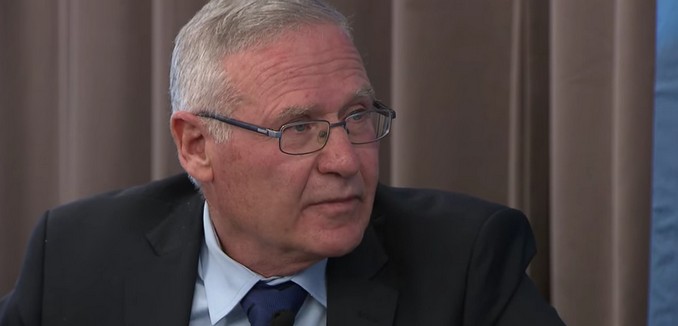The West must reestablish a credible threat of force in order to restore eroded leverage with Iran according Amos Yadlin, former head of Israel’s military intelligence and director at the Institute for National Security Studies (INSS), and INSS researcher Avner Golov.
In an article published Wednesday, Yadlin and Golov argued that the West must avoid a bad nuclear deal with Iran, which they described (INSS link) as follows:
An agreement that leaves Iran’s breakout capacity where it stands today — several months from a bomb — is a bad deal. It would keep Iran far too close to having nuclear weapons, making it extremely difficult to stop Tehran if it decided to weaponize. Under no circumstance should such a deal be signed. Rather, an agreement with Iran must make certain that, if Tehran chooses to break (or sneak) out to a nuclear weapon, it would need several years to get there, thereby giving the West enough time to deal with the dangerous move.
The authors presented the parameters that must be insisted upon to conclude a favorable nuclear deal.
Thus, the challenge facing the United States and other world powers as they continue their negotiations with Tehran is to dismantle crucial elements of the Iranian nuclear program that could be used for military purposes. First and foremost, Washington must insist on a drastic reduction in the number of centrifuges to a maximum quantity of 3,000 to 4,000 centrifuges, along with a stockpile of enriched uranium lower than the minimum required for a single nuclear bomb. These constraints should last for two decades. Second, unprecedented monitoring of all aspects of the Iranian nuclear program is
required. This scrutiny must be based on the International Atomic Energy Agency (IAEA) Additional Protocol and Iran’s positive response to opening files on military nuclear activities. International inspection should not be a voluntarily mechanism, but a binding one. Third, Tehran must agree to the conversion of the Fordow enrichment facility and the heavy-water reactor in Arak so that they cannot be used for military purposes. Lastly, the sanction-relief mechanism should be gradual and in accordance with Iranian progress in rolling back the nuclear program.
Yadlin and Golov warned that if Iran is not constrained from developing a nuclear weapon, that may “stimulate other Middle Eastern countries to acquire nuclear capabilities.” However, the problem negotiators face is “forcing Tehran’s hand to do something it clearly does not want,” and Iran has so far refused to roll back its nuclear program to the parameters that would define a good deal.
Yadlin and Golov consequently argue that the United States “must maintain and rebalance its two levers of pressure on Tehran,” the first of which is sanctions. Though the authors acknowledge that sanctions “succeeded in persuading Iran in 2013 to engage in meaningful negotiations,” they fear that the erosion of sanctions make it “difficult for the United States to maintain an effective sanctions regime that would change the Iranian calculus.” So a second lever- the threat of military action- must be utilized as well.
Therefore, Washington must restore the credibility of its second lever for pressuring Iran — the threat of a military strike. Washington must restore the credibility of its second lever for pressuring Iran — the threat of a military strike. President Obama’s airpower war against the Islamic State can be a great help. The pinpoint strikes in Iraq and Syria can be much more effective against stationary targets than in a counterterrorism campaign. Washington should adapt this model and make clear to Tehran that if the supreme leader is not prepared to make concessions on key elements of the nuclear program that could be used for military purposes, it will be forced to consider a surgical aerial strike against nuclear facilities. This lever, if resolute, could induce Iran’s leaders to agree to a nuclear program that includes very limited and supervised self-enrichment, so that its program cannot serve as cover for a military nuclear one.
The authors conclude that “[o]nly if the United States establishes a credible military threat and maintains the sanctions regime can it reach a good deal with Iran.”
Yadlin and Golov outlined (Google link) these same parameters last year in The Wall Street Journal.
In Senate testimony this week, Michael Doran, a senior fellow at the Hudson Institute, argued for increased sanctions as a means for restoring the West’s eroded leverage in the nuclear negotiations with Iran.
[Photo: GermanMarshallFund / YouTube ]




